946. Carrige maker's circular plough plane, made by Thomas Falconer, it's for cutting grooves in a curved surface. This tool won a Silver Medal from the Royal Society of Arts in 1846. I took these photos at an auction where the estimated value of this plane was $22,000-$26,000, I didn't stay to find out what it actually sold for.
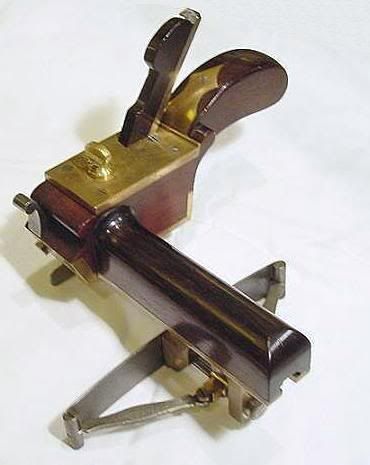
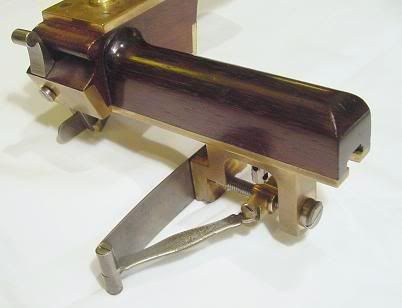
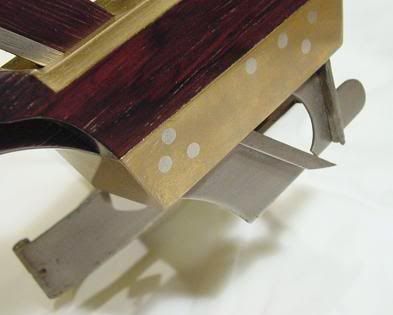
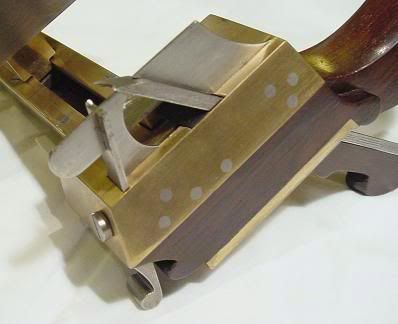
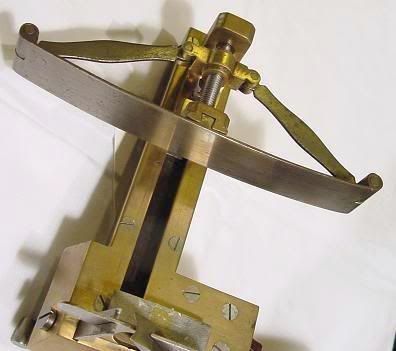
Claire Batley from the Royal Society of Arts describes the Silver Medal award:
947. Nutcracker, placed on the knee when seated, a nut is set in the hole and then struck with a hammer. In the winter, these were warmed by the fire before using.
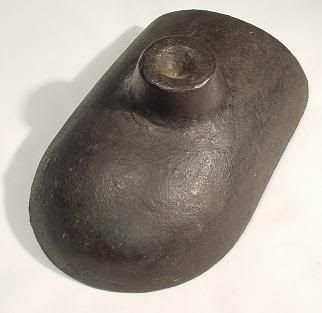
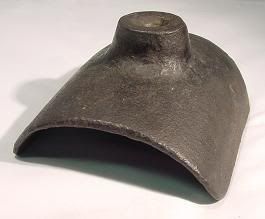
948. Cobbler's or leather worker's hammer, used to make holes in leather. A bit inside the spring holds a nail by the head, the spring automatically extricates the nail after a hole has been made.
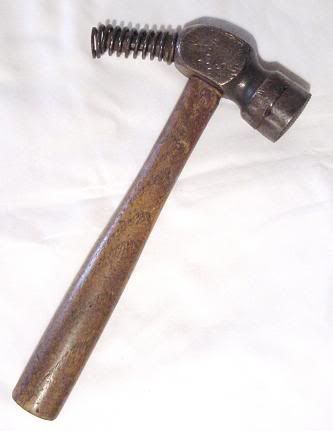
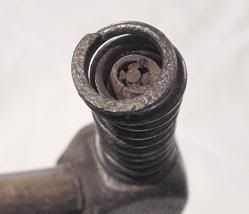
949. This is a doctor's spring loaded fleam or scarificator, used for blood letting. The lever on the side is pulled out and the piece on the right is pulled up to set it, the side lever is then pushed to release the spring and actuate the blade.
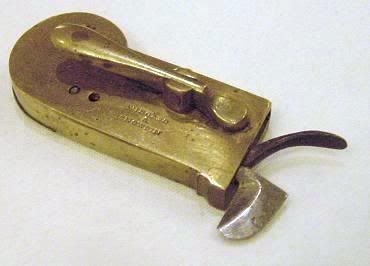
950. Mountain climber's boot attachment for icy terrain, it's missing the straps.
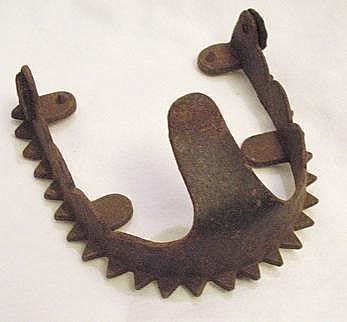
951. A3P star projector by Spitz Space Systems, used in a planetarium, more info on the individual parts can be seen here.
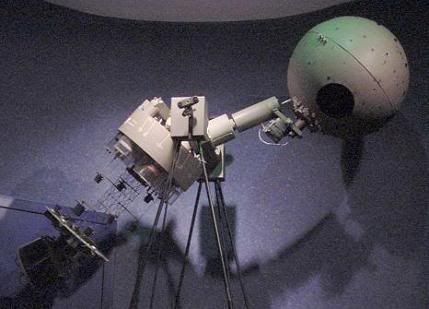
Update:
860. This device is a watchmaker's Geneva glass gauge.
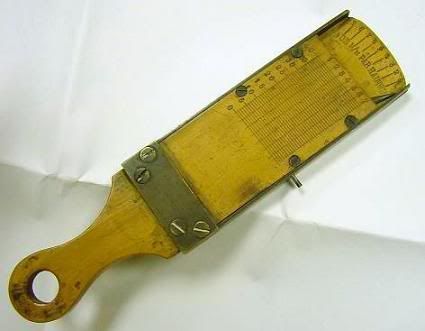
According to the Source Book for Rule Collectors:
Thanks to Virginia White, Mid-West Tool Club "What's It" Columnist, and Otto van Poelje for providing the answer to this one.
More photos of this gauge can be found on the original answer page.
Another Geneva glass gauge has been posted here on ebay, where it is theorized that the pin on the side measures the inside height of the dome of the glass, pushing the pin moves the needle at the top of the gauge.
Last week's set is seen below, click here to view the entire post:
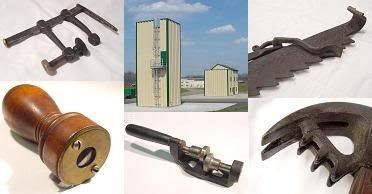
More discussion and comments on these photos can be found at the newsgroup rec.puzzles.





Claire Batley from the Royal Society of Arts describes the Silver Medal award:
"From its very earliest years, the Society of Arts offered premiums (prizes) in a numbers of 'classes' (fine arts, chemistry, agriculture, manufactures, mechanics and Colonies and Trade) in order to encourage and inspire progress and innovation. In many classes the premiums were offered for very specific achievements and the prize attached to it would be published, be this a gold medal, a silver medal or a monetary reward. In most instances though, it was not a case of a gold medal for the best, silver for the second best etc, but one or the other, or money.
Premiums for the class of mechanics were defined in broader terms than some of the others, thereby allowing 'inventors' to enter new or improved items for all manner of purposes. As a consequence of the premiums not being specific it is not possible to be certain which of them Mr Falconer's entry related to, or whether, in other years, anyone else had brought an "improved circular plough" for the Society's consideration. However, it appears that Mr Falconer's entry was related to either the premium for the "improvements in the machinery used in manufactures" or that for "improvements in the tools used in the various handicraft trades".
The premiums offered in mechanics did not have specific rewards attached to them, apparently because the premiums were so broad and the entries so diverse. Each entry was considered on its own merits and was awarded the gold or silver medal, a pecuniary reward, or an Honorary Testimonial according to circumstances.
Mr Falconer's plough would not have been judged in competition with any other plough, and its award of a Silver Medal does not imply that there was a simultaneous recipient of a gold medal. Rather, the entry would have been made in response to the broad premiums offered, and judged on its own qualities. The fact that Falconer was awarded not only the Silver Medal but also a monetary reward shows that the committee that considered it believed it had merit."
947. Nutcracker, placed on the knee when seated, a nut is set in the hole and then struck with a hammer. In the winter, these were warmed by the fire before using.


948. Cobbler's or leather worker's hammer, used to make holes in leather. A bit inside the spring holds a nail by the head, the spring automatically extricates the nail after a hole has been made.


949. This is a doctor's spring loaded fleam or scarificator, used for blood letting. The lever on the side is pulled out and the piece on the right is pulled up to set it, the side lever is then pushed to release the spring and actuate the blade.

950. Mountain climber's boot attachment for icy terrain, it's missing the straps.

951. A3P star projector by Spitz Space Systems, used in a planetarium, more info on the individual parts can be seen here.

Update:
860. This device is a watchmaker's Geneva glass gauge.

According to the Source Book for Rule Collectors:
The sizes of watch glasses are expressed in either Geneva or Lunette measurement, two different standards developed in Switzerland. Geneva measurement is expressed in units and 16ths, where a unit is approximately equal to .0825 of an inch, thus a watchmaker would say that a Waterbury watch takes a 18 1/16 Geneva crystal.
The crystal being measured would be placed on the surface of the gauge, its lower edge resting against the step, and its diameter determined by what graduation line it touched at its upper edge.
Thanks to Virginia White, Mid-West Tool Club "What's It" Columnist, and Otto van Poelje for providing the answer to this one.
More photos of this gauge can be found on the original answer page.
Another Geneva glass gauge has been posted here on ebay, where it is theorized that the pin on the side measures the inside height of the dome of the glass, pushing the pin moves the needle at the top of the gauge.
Last week's set is seen below, click here to view the entire post:

More discussion and comments on these photos can be found at the newsgroup rec.puzzles.

